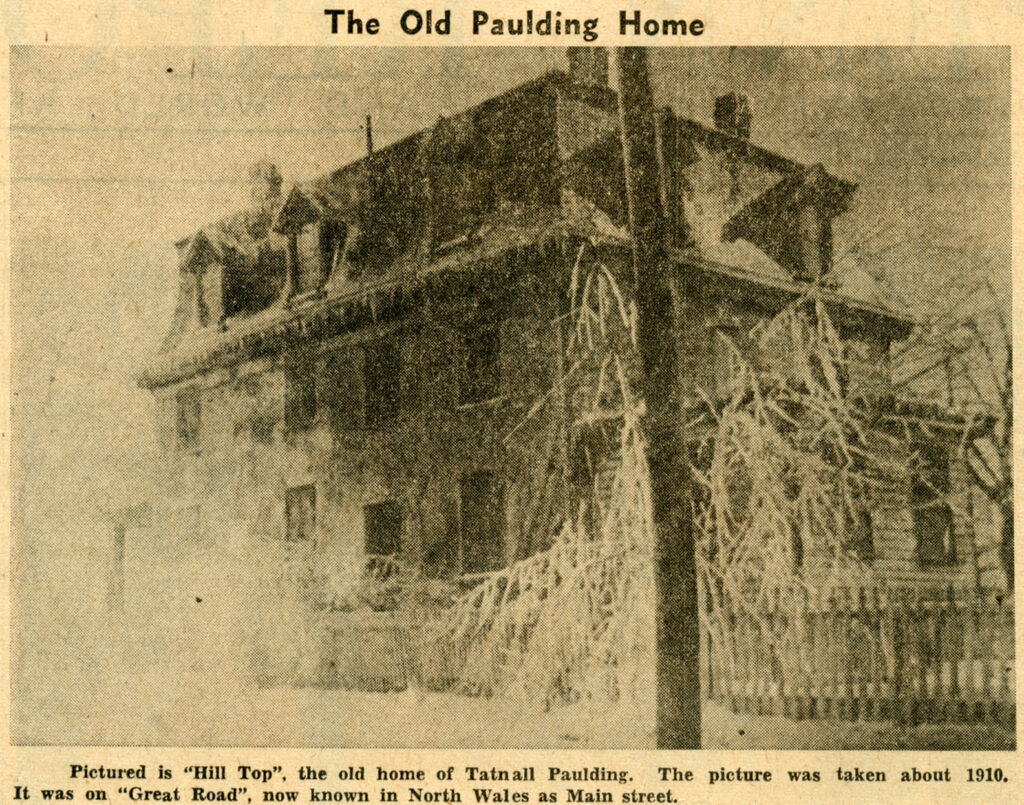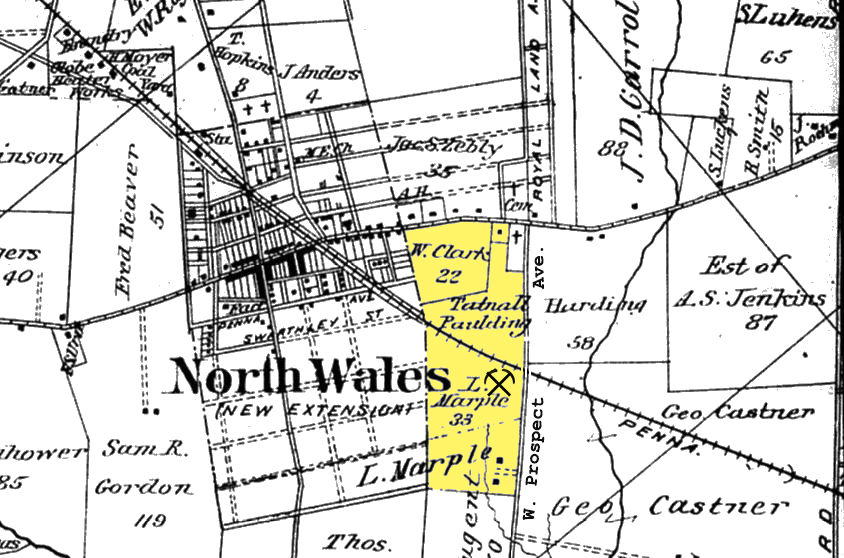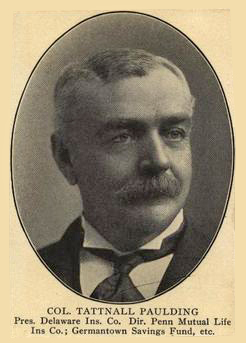After discussing the Zebley property, let us now cross S. Main street and trace the history of the ground on the south-west side of the Great Road, or the property of the late Tatnall Paulding, which now comprises all that ground between the home of W. Palmer King and West Prospect avenue, extending south to the railroad. [Today this part of North Wales includes Highland Avenue, Fairview Avenue, and St. Rose of Lima Church.]
This property, when bought by Paulding, comprised twenty-one acres, but this was fast diminished by the steady growth of the borough. The property was a triangle lying between the Reading Railroad and Main street. To the southeast it was bounded by Church road (now known as West Prospect avenue) and the new Lutheran Cemetery. In the olden times there was a large plantation comprising also the Zeber Marple farm (in 1959 the Henry Strong property) beyond the railroad.

The dwelling, which stood on the site of the Benjamin H. Miller home, was built of stone with a rear wing, and was quite close to the highway. The stone barn was to the rear. The dwelling, though having a modern appearance, was quite old, but was remodeled by Mr. Paulding. The stone walls of the house had a yellow coating of plaster and it is known that before 1840 Frederick Weber lived here as a tenant.

The crossed pickaxe symbol represents the location of Hill-Top Quarry
This farm which earlier included the Marple farm across the railroad, is also a fragment of the patent of 720 acres confirmed in 1702 to Robert Jones. Just for the benefit of those future local historians who are showing such a great interest in these articles, we must repeat that this vast tract of 720 acres which belonged to Robert Jones extended across Gwynedd township for two miles from its northeast boundary, and was a half mile in width. It covered the site of North Wales and was held by Jones until his death 30 years later. He is supposed to have lived eastward of the present town at the George Jones place, or the present C. J. Fisher property. His will of 1732 conveyed to his son, John Jones, 300 acres upon which the latter then lived. His home was probably within the present borough, and was either northward of the present Rorer-Seems building or at the present apartment house at Shearer street and Pennsylvania avenue.
The Jones ownership finally ended in 1760, when John Jones and his wife, Gainor, sold 186 acres to George Weidner. All of this lay on the southwest side of the present Main street. The price was 546 pounds. Concerning what manner of man was this John Jones, who flourished here for three decades of the 18th century, we have no record. There is a record of the death of John Jones, carpenter, in 1775.
At some time prior to the Revolution George Weidner, who was a Lutheran or Reformed, had sold his plantation, or at least the greater part, to Jacob Wyant.
In 1776 Wyant was credited with owning 130 acres, 3 horses and 4 cows. In 1784 he sold off 29 acres of the southwest corner to William Rex. In 1776 Steven Bloom was credited with 35 acres, 2 horses and 2 cows.
In 1787 a property comprising 53 acres, which covered this tract and belonging to Daniel Boone, a blacksmith, was seized by the sheriff and sold to John Roberts. This, or at least part of it, had been, before 1780, a part of the estate of Philip Heist, who in 1776 had 120 acres. In 1795 John Roberts added seven acres, having bought them from the administrator of Hugh Evans. This lot probably lay southwest of West Prospect avenue. This purchase gave Roberts 62 acres. It had no improvements and was bought for 70 pounds. Hugh Evans had gotten it from his father, Thomas Evans, who died in 1784 and he, himself, died in 1789.
John Roberts was the owner of the farm for 11 years, or until 1798 when he sold to Philip Summers, of Gwynedd, for 65 pounds. This was bounded on the southwest for 48 perches of land of Rees Harry and Philip Hurst, on the northwest for a half mile by lands of Philip Hurst to the Great Road [Sumneytown Pike], and by the Road on the northeast side 49 perches; on the southeast side by lands of Martin Schwenk and Thomas Evans for 186 perches. It was a long narrow strip that Summers bought. It was later surveyed to contain 64 acres.
Philip Summers was the grandson of Hans George Summers, an emigrant, who arrived in Philadelphia from Germany in 1754 along with his wife Barbara Maria. Philip Summers and his wife were members of the old Yellow Church, North Wales and were Lutherans. Three of their sons were elected trustees, deacons and elders. They were Martin, Philip, Jr., and John. This Philip died on May 6th, 1814. His wife lived to be quite old, or until 1838. The second Philip Summers was the purchaser of the Gwynedd farm in 1798 from John Roberts and of which he was the owner for 29 years. He sold to John Robinson on March 20, 1827. He then removed to Philadelphia where he died on June 3, 1834.
The later history of this property is one of many changes of ownership which can only be briefly mentioned. The Marple and Paulding places continued as one farm for a long period of time. Robinson held it for a dozen years. In 1839 he sold to Daniel Miller. In 1852 Miller sold to Peter Wells Moore. In 1857 Moore was living in Upper Merion when he sold to Lawrence Corson, a real estate dealer of Norristown, the 62 acres. The North Pennsylvania Railroad [today the SEPTA Lansdale line] had cut the property in two 1856. In 1859 Corson sold to J. Sigmund Reichle for $4500. In 1862 the latter sold the 56 acres back to Corson for $4100. Next year Corson gave title to Jacob Mathias who conveyed to Charles Snyder in 1864.
By this time the Marple farm had become detached. So in 1865 Snyder sold the 21 acres on the east side of the railroad to Clarinda Reeve, of Philadelphia, for $2100. The same year she sold to Mathias Schwenk for $2475. Mathias Schwenk came to stay, and there were no more changes for 17 years. In 1882 he sold to Sara Jane Clark for $5000. He had built a new house. Finally in 1890 Clark sold to Col. Tatnall Paulding, Civil War veteran and prominent businessman residing in Germantown. Paulding the same year bought a lot adjoining the 21 acres, having a house on it, from William J. Clark for $1000.

Mr. Paulding named his farm the Hill-Top Farm, and in June of 1892 he also operated the Hill-Top Quarry which was on the south side of the railroad and a short distance west of West Prospect avenue, at which place he sold stone for building, paving and curbing. The remains of this quarry can still be seen today [1959]. In November of 1892 the Reading Railroad ran a switch into this quarry to facilitate the shipment of stone to Philadelphia. In March of 1895 the Reading Railroad Company ordered all work in the quarry discontinued because of the blasting, at which time stones were thrown upon their tracks causing damage to passing trains.
Tatnall Paulding died March 3, 1907. His farm remained idle until May of 1912, when it was sold to Dill & Fenstermacher for development purposes.
This post is sourced from a column entitled Early North Wales: Its History and Its People penned by long-time North Wales resident historian Leon T. Lewis. The article appeared in its original form in the April 21, 1959 issue of the North Penn Reporter.
